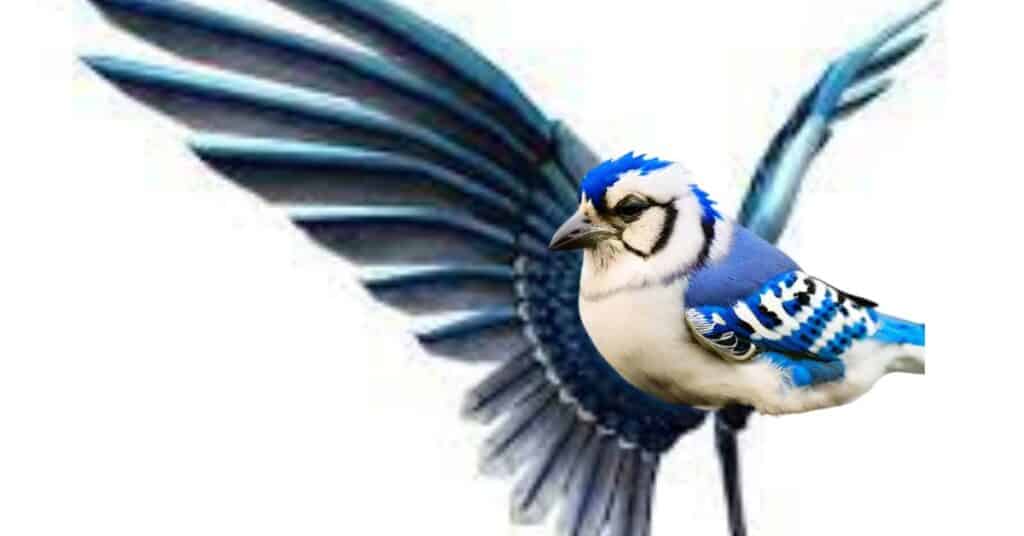What do you know about Blue Jay Wings? Find out everything on Blue Jay Wings in this blog post where i share my findings and thoughts.
I was out in nature one day when I saw a blue jay sitting on a branch. It suddenly spread its wings and showed a beautiful scene. The wings were a gorgeous mix of blue, black, and white that looked amazing against the sky.
As the blue jay flapped its wings gracefully, it seemed to stand for freedom and life. I couldn’t help but be amazed by how simple and beautiful the blue jay’s wings were. They were a true work of art in nature.
From the vivid blue color to their distinctive crested heads, blue jays are majestic birds that captivate our attention. While their appearance is striking, the intricate design of their wings truly sets them apart.
In this article, we will delve into the fascinating world of blue jay wings, exploring their structure, functions, and the extraordinary capabilities they enable.
To learn If Blue Jays Mate for Life click here.
Facts and Statistics of Blue Jay Wings
| Facts | Info |
|---|---|
| Length | Blue jay wings typically measure about 18 inches in length. |
| Wingspan | The wingspan of blue jays can reach up to 30 inches. |
| Feathers | Blue jay wings consist of primary feathers, secondary feathers, and tertiary feathers. |
| Primary Feathers | Primary feathers are the longest feathers on the wing, providing thrust during flight. |
| Secondary Feathers | Secondary feathers are located behind the primary feathers and help provide lift. |
| Tertiary Feathers | Tertiary feathers, located at the far edge of the wing, help stabilize the bird in flight. |
| Coloration | Blue jay wings are a beautiful shade of blue with black and white markings. |
| Pigment | The blue coloration is caused by the pigment melanin. |
| Markings | Black and white markings are a result of the arrangement of the feathers. |
| Functions | Blue jay wings are used for flying, gliding, flapping, and for display purposes. |
The Anatomy of Blue Jay Wings

Feather Composition
Blue jay wings consist of an intricate arrangement of feathers, each serving a crucial purpose. These feathers are composed of a central shaft, called the rachis, which extends from a base towards the tip. The rachis is lined with interlocking barbs that form the feather’s vane, providing strength and durability.
Wing Shape and Size
Blue jays possess large, rounded wings that enable agile flight and quick maneuverability. These wingspan typically range from 13 to 17 inches, allowing blue jays to easily navigate through dense vegetation or open spaces.
Wing Coloration
The primary wing feathers of blue jays showcase a deep shade of blue, contrasting beautifully against the black markings on their wings. This vibrant coloration adds to their aesthetic appeal and plays a role in communication and identification within their social group.
The Functionality of Blue Jay Wings

Flight Capabilities
Blue jays are skilled fliers, capable of soaring through the air with grace and precision. Their wings provide the necessary lift and thrust required for sustained flight. They can adjust their speed, altitude, and direction through a unique combination of wing movements, effortlessly gliding through various environments.
Acrobatic Abilities
Blue jays possess exceptional agility, allowing them to perform intricate aerial maneuvers. Their wings enable them to swiftly change direction, execute sharp turns, and even hover momentarily. This agility is especially useful when navigating dense forests or evading potential predators.
Vocalization and Communication
Apart from its primary function in flight, blue jay wings also serve as a secondary tool for communication. Blue jays in flight produce a distinctive rattling sound by rapidly flapping their wings. This behavior serves as a vocalization mechanism, enabling them to communicate with other individuals within their group.
Adaptations and Evolution

Wing Structure Adaptations
Over time, blue jays have evolved specific adaptations in their wing structure to suit their lifestyle. The sturdy composition of their feathers ensures durability and resistance to wear and tear, allowing them to navigate through various environments and endure long flights during their migratory journeys.
Wing Morphology
The rounded shape of blue jay wings helps optimize their flight efficiency. This wing morphology reduces drag and allows for enhanced lift, making it easier for blue jays to take off, stay airborne, and land gracefully.
Feather Maintenance and Health
Blue jays meticulously maintain their feathers to ensure optimal flight performance. Through preening, they remove dirt, parasites, and damaged feathers. This grooming process helps maintain their wings’ integrity and ensures smooth, silent flight.
Conclusion
Now that we learned about Blue jay wings, I can say that they are a marvel of nature’s ingenuity. Their intricate anatomy, functionality, and unique adaptations showcase the remarkable capabilities of these avian creatures.
From their vibrant blue coloration to their acrobatic aerial skills, blue jays continue to amaze and inspire us with their majestic wings.
I hope this article is useful. If so, consider subscribing to my weekly newsletters for trends and updates.
Click here to learn What Color are Blue Jay Eggs
FAQs (Frequently Asked Questions)
How fast can blue jays fly? Blue jays can reach up to 20 to 25 miles per hour on routine flights.
Can blue jays swim?
While bluejays are primarily land- birds, they can swim short distances if necessary, using their wings as paddles.
Do blue jays migrate?
Yes, many blue jays migrate during winter, traveling to warmer regions for food and favorable conditions.
What is the purpose of the blue jay’s crest?
The crest on a blue jay’s head play a role in communication, helping to convey various social signals within the group.
Can blue jays mimic human voices?
Yes, Blue jays can mimic various sounds, including human voices, though not as accurately as some other bird species.

